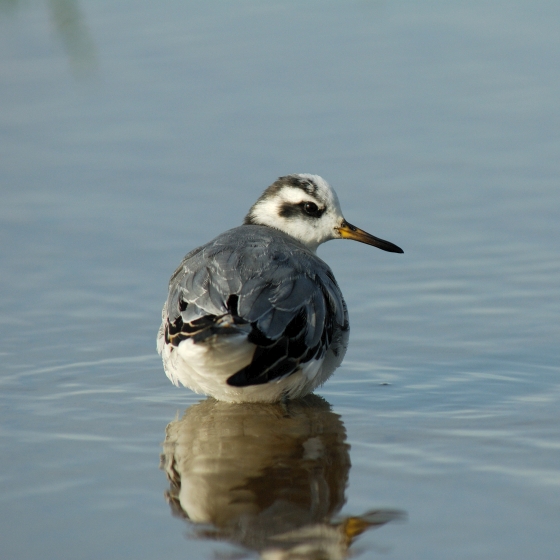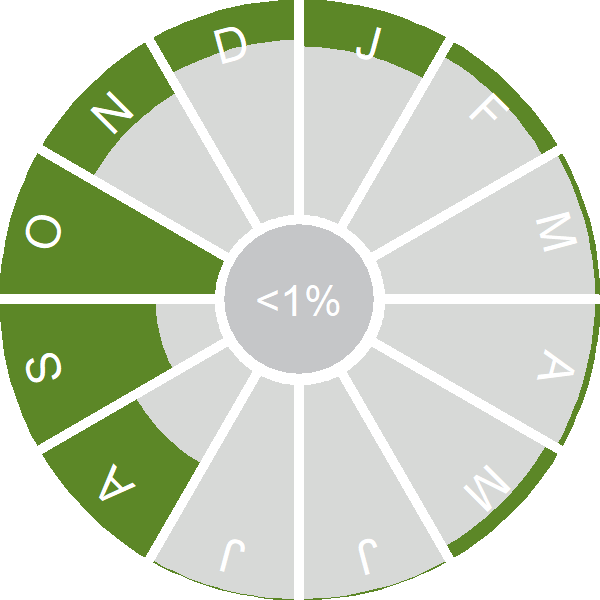Grey Phalarope

Introduction
The Grey (or Red) Phalarope is a small, Arctic breeding wader that has very different plumages in summer and winter.
Records of this small Arctic visitor peak in late autumn (from mid-September through December). Normally, it occurs offshore but storm-driven individuals can also be found on large inland waterbodies, where they can be surprisingly approachable.
Phalaropes swim with a distinctive spinning motion, creating small vortices of water that are thought to bring small invertebrates to the surface where they can pick them off the surface with their short delicate bill.

Key Stats
Status and Trends
Conservation Status
Population Size
Population Change
The Grey Phalarope is a scarce migrant in the UK, seen on (mostly autumn) passage in highly variable numbers each year, usually in the low hundreds but in much higher numbers in exceptional years; they are almost exclusively seen in coastal locations, with only occasional records from inland reservoirs [White & Kehoe 2024].
Distribution
The winter range map for Grey Phalaropes shows records mainly along the North Sea from the Firth of Forth southwards, and along the south coast of England, and north to the southern Irish Sea, plus a scattering of inland records in south and central England. Most of these records come form November when birds are still migrating.
Occupied 10-km squares in UK
2007/08–10/11
or view it on Bird Atlas Mapstore.
2008–11
or view it on Bird Atlas Mapstore.
European Distribution Map
Distribution Change
Change in occupied 10-km squares in the UK
from 1981–84 to 2007–11
or view it on Bird Atlas Mapstore.
Seasonality
Grey Phalaropes are most often encountered during autumn storms, particularly in September and October, but winter records are also possible.
Weekly pattern of occurrence
The graph shows when the species is present in the UK, with taller bars indicating a higher likelihood of encountering the species in appropriate regions and habitats.

Movement
Britain & Ireland movement
Foreign locations of birds ringed or recovered in Britain & Ireland
Dots show the foreign destinations of birds ringed in Britain & Ireland, and the origins of birds ringed overseas that were subsequently recaptured, resighted or found dead in Britain & Ireland. Dot colours indicate the time of year that the species was present at the location.
- Winter (Nov-Feb)
- Spring (Mar-Apr)
- Summer (May-Jul)
- Autumn (Aug-Oct)

Biology
Productivity and Nesting
Nesting timing
Egg measurements
Clutch Size
Survival and Longevity
Survival is shown as the proportion of birds surviving from one year to the next and is derived from bird ringing data. It can also be used to estimate how long birds typically live.
View number ringed each year in the Online Ringing Report.
Biometrics
Wing length and body weights are from live birds (source).
Ring Size
Classification, names and codes
Classification and Codes
- Order: Charadriiformes
- Family: Stercorariidae
- Scientific name: Phalaropus fulicarius
- Authority: Linnaeus, 1758
- BTO 2-letter code: PL
- BTO 5-letter code: GREPH
- Euring code number: 5650
Alternate species names
- Catalan: escuraflascons becgròs
- Czech: lyskonoh ploskozobý
- Danish: Thorshane
- Dutch: Rosse Franjepoot
- Estonian: puna-veetallaja
- Finnish: isovesipääsky
- French: Phalarope à bec large
- Gaelic: Liathag-allt
- German: Thorshühnchen
- Hungarian: laposcsoru víztaposó
- Icelandic: Þórshani
- Irish: Falaróp Gobmhór
- Italian: Falaropo beccolargo
- Latvian: platknabja puslitis
- Lithuanian: plokšciasnapis plaukikas
- Norwegian: Polarsvømmesnipe
- Polish: platkonóg plaskodzioby
- Portuguese: falaropo-de-bico-grosso
- Slovak: lyskonoh ploskozobý
- Slovenian: ploskokljuni liskonožec
- Spanish: Falaropo picogrueso
- Swedish: brednäbbad simsnäppa
- Welsh: Llydandroed Llwyd
More Evidence
More evidence from Conservation Evidence.com
Partners
Citing BirdFacts
If you wish to cite particular content in this page (e.g. a specific value) it is best to use the original sources as linked in the page. For a more general citation of the whole page please use: BTO (20XX) BirdFacts Species: profiles of birds occurring in the United Kingdom. BTO, Thetford (www.bto.org/birdfacts, accessed on xx/xx/xxxx).

